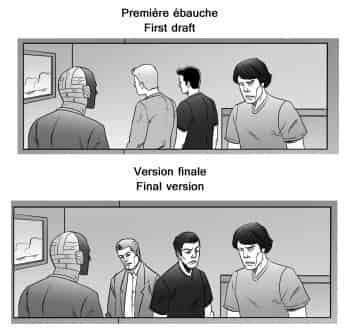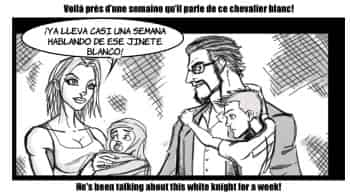Bonus
-
If it ain’t broke…
We happened upon an interview with Michael G. Wilson, who explains the success of the Bond franchise. One of the points he makes is that the team tried to reinvent the myth before it could become too hackneyed (Edward Cross, “Skyfall Exclusive: An Interview with Producer Michael G. Wilson,” www.comicbookmovie.com, February 13, 2013). Similarly, Harvey Weinstein admits he made some mistakes in promoting the movie The Master, which resulted in it not reaching its audience (Sean O’Connell, “Harvey Weinstein Admits He Mis-Marketed The Master,” www.cinemablend.com, January 29, 2013). These two statements in our opinion demonstrate a kind of humility: admitting our errors allows us to learn something that can be applied to similar situations in the future.
-
Touch-ups (Virus Part III)—Continued
Comics are a team endeavour. It sometimes happens that the writer will ask an artist to modify an image to enhance the overall consistency. In this story we felt that the body language in the drawings of Benson and Jason looked too casual for the conversation. They also lacked consistency with the following panel.
-
Trading in one form of fanaticism for another
We’ve already talked about the film Zero Dark Thirty, but a few months ago we came across a critique of the DVD release in which the author discusses Maya, the hero of the film: “Her fanatical pursuit of Bin Laden helps to neutralise ordinary moral qualms… This awareness of the torturer’s hurt sensitivity as the (main) human cost of torture ensures that the film is not cheap rightwing propaganda: the psychological complexity is depicted so that liberals can enjoy the film without feeling guilty. This is why Zero Dark Thirty is much worse than 24, where at least Jack Bauer breaks down at the series finale. “
We find the idea of one form of fanaticism being replaced by another very interesting, and more so that the story can allow viewers to detach from a conflict that would normally affect them (Slavo Zizek, “Zero Dark Thirty: Hollywood’s Gift to American Power,” The Guardian, Friday, January 25, 2013).
-
But what were they saying? (White Knight)
-
Shaking up the conventions
We’re coming back to ideas we’ve already discussed but with new references that provide food for thought. There’s a fine line between formula and conventions in any type of film. In his analysis of Die Hard, Darren points out that the movie worked well because it made use of all the action-film conventions without turning the script into a checklist of items to cover (Darren, “Non-Review Review: Die Hard,” them0vieblog.com, January 8, 2013).
The concept of conventions may be more difficult to transcend in the West, where stories are generally built around a clash between two or more elements that is ultimately resolved by one dominating the other. It can become difficult to develop new ideas within such a paradigm. In this context killing off the main character can be a way to gain some dramatic momentum. Unfortunately this cliché is used too often to try to breathe new life into a series, and it no longer fazes readers who know very well that the character will come back from the grave (Mike Romo, “RIP Peter Parker (Again), RIP My Faith in Marvel (Again),” http://ifanboy.com, July 1, 2013). Returning from the dead cancels out the dramatic impact and any possible learning because too often this return means a return to the status quo or to the situation that preceded the tragedy (Steve Morris, “Second Opinion: Batman # 17” http://comicsbeat.com, February 15, 2013). Morris also believes that these concepts are those of the authors and are not always consistent with the spirit of the characters or the series being developed.
One solution is offered by Mark Waid in his stories that emphasize more intimate stakes. In this sense, McMillan is targeting key elements of Hawkeye, developed by Matt Fraction: “The excitement here is that Hawkeye doesn’t wear his costume all that much and acts like a real life human being once in a while. He cracks some jokes and has some sense of his own mortality when he or his friends get shot at. He is hopeless at superheroics (i.e. fallible)” (Graeme McMillan, “What Makes Hawkeye So Special?” Newsarama, May 8, 2013). To successfully convey smaller-scale dramas, the author needs the time to develop them. Daniel Champion offers an interesting idea: “That’s ‘story’ and so often in comics, we don’t see it. A story is about something and is told through moments that happen. In comics, we only ever seem to get a bunch of things that happen, with no ‘about’ […] and that’s a waste” (Daniel Champion, “Comics is Sh*t,” www.comicbookdaily.com, January 29, 2013.). The story happens beyond the events taking place in the panels. Taking the time to develop a story can mean introducing characters that will only reveal themselves later on (Graeme McMillan, “…Who is that Again?” Newsarama, January 30, 2013).







